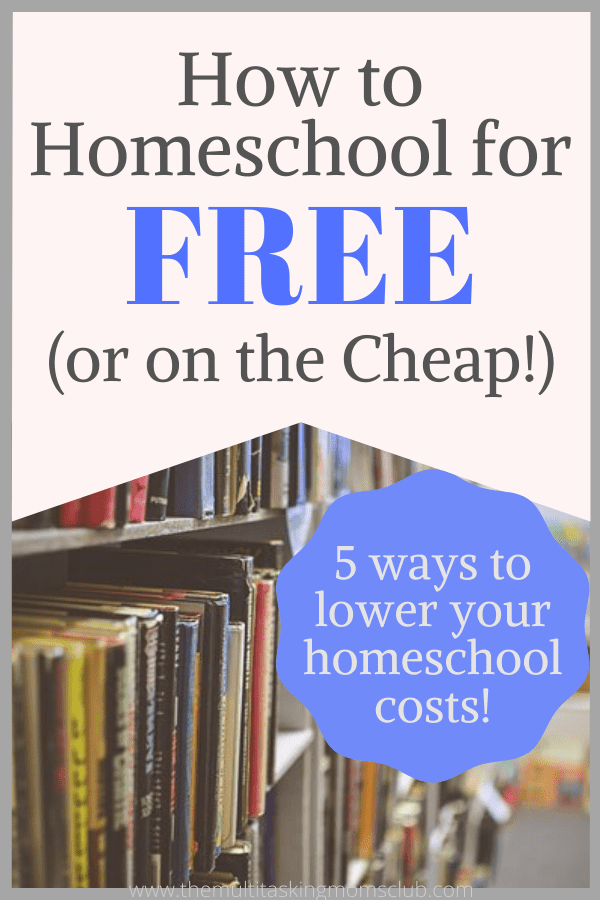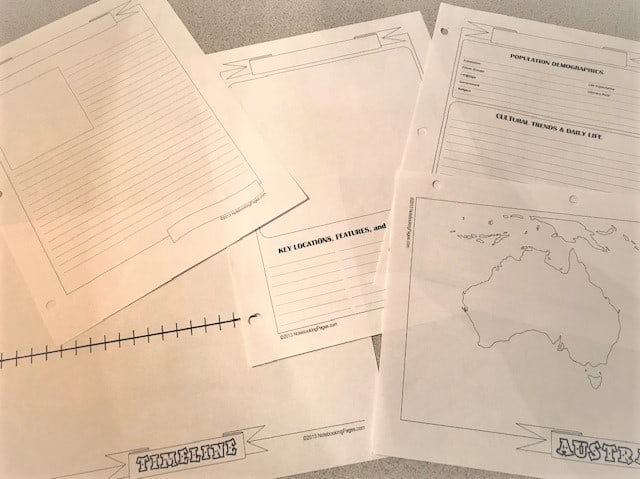If you have spent any time perusing homeschool catalogs, you may be doubting that anyone could possibly homeschool for free!
But, it is possible! At the very least, homeschooling can be done very, very cheaply.
I will say, I still hit the school supply aisle at the store a little too often (but only if on sale) and I did invest a huge chunk of change in a really, really awesome laser toner printer about 6 years ago that I use to print free worksheets and notebooking pages. Those 2 things alone have saved us a TON of money over the years.
So, admittedly, I haven’t homeschooled completely for free, but I don’t spend a ton of money on curricula. Some years, I don’t spend any money at all on curricula! My daughter is in 11th grade this year and I haven’t spent a dime.
Well, scratch that. I did buy a packet of ballpoint pens and a few composition notebooks during the back-to-school sale… but no curricula.
Nonetheless…
Here are 5 methods we have used over the years to keep costs down.

This post may contain affiliate links. Please see my Disclosure Page for details. As an Amazon Associate I earn from qualifying purchases.
1. Free online curriculum
There are numerous free, complete curriculums on the internet. There are also some that are very inexpensive.
There are also subject-specific options for free or cheap.
State online schools – most states offer a free K-12 at-home public school option. Many states will also include a laptop for free. Bear in mind, this option is not very flexible as it is all or nothing. If you choose this option, all of your child’s classes will be done through this program and they will be considered public school students. There is no flexibility to move at your own pace.
Easy Peasy All-in-one Homeschool – Easy Peasy is a free online option put together by a homeschool mom. You have the option to cover all your child’s subjects, or just pick a few subjects. This is a very flexible option, especially for the child who needs to move at their own pace. If you ever get stuck, Easy Peasy has an awesome Facebook group that can help you along the way.
Ambleside Online – Ambleside is a free Christian homeschool curriculum that uses the Charlotte Mason technique of education that is rich in literature and living books. All the books you will need are listed on the site and many of the books are free online. Or, you have the option to buy the books or check them out of the library for free. Note: you will need to add your own math curriculum.
Kahn Academy – If you need a free online math curriculum, Khan Academy can’t be beat. It is the go-to for many homeschool families. But, did you know, Khan Academy offers lessons in numerous other subjects, also? Art and Humanities, Science and Engineering, and more can also be found on Khan.
SchoolhouseTeachers.com – SchoolhouseTeachers.com is my favorite low-cost option for homeschooling all grade levels! For $19.95 a month, your entire family will have access to over 430 different classes. More than enough to put together a complete curriculum. There are even classes for adults. All classes are self-paced and flexible. This is an especially great deal for large families.
Time4Learning – Time4Learning is another low-cost option for a complete curriculum for all grade levels. Though not as thorough as SchoolhouseTeachers, nor as cheap, Time4Learning is a good option for those looking to save money. All courses are self-paced, which helps with flexibility. Unfortunately, you must register and pay for each student separately.
e-Learning for Kids – e-Learning for Kids offers mainly Math and Science lessons for children in K-6 for free. This is not a complete curriculum, as they only offer individual lessons. But, you can create your own curriculum using this material. They are continually adding Language Arts, Health, Life Skills lessons and more. Some of the lessons would even be good supplements for older students.
Curriculum Pathways – Curriculum Pathways is another free option for lessons you can use in your homeschool, much like e-Learning for Kids. This is not a complete curriculum, but they do offer lessons in all grade levels that you can use to teach your own children.
SchoolhouseTeachers.com
2. Make Your Own Unit Studies
Creating your own unit studies is also a great way to save money.
Just pick a topic – let’s say the Renaissance for this example. Go to the library and check out books about the Renaissance, including history, geography, art, architecture, science, and biographies.
Look up YouTube videos for lessons and documentaries about the Renaissance.
Check through some of the free or low cost options mentioned above and see if you can find any lessons about the Renaissance.
Next, think of each subject and approach the Renaissance from that angle.
For example, Language Arts could include reading historical novels, writing poetry about the time period, doing copy work out of library books, etc. You can also create Spelling and/or Vocabulary lists from your books.
Social Studies would include map work of Europe, history book readings, and free online videos followed by short written reports or even a reenactment written and performed by your children.
Science would include a study of the discoveries of the Renaissance and the scientists behind those discoveries. You can dig deeper into each topic, such as Sir Isaac Newton’s theory of gravity, by looking up chapters on that topic in science books. Youtube also has a huge selection of science experiments you can recreate at home.
You can even throw in Math by counting castles, calculating population densities, finding the circumference of domes in Renaissance architecture, or studying calculus as the Renaissance thinkers did.
The possibilities are endless, inexpensive, and far more fun than boring textbooks that cost a fortune!
3. Make Use of the Library
Beyond using the library just to find books for unit studies or fun reading, most libraries also have a wide selection of textbooks.
If creating a unit study or just winging your child’s education is too outside the box for you, check out what your library has to offer in terms of textbooks, learning programs, videos, and even classes.
Many libraries have complete phonics programs or reading instruction books. Many have math and science textbooks. Some libraries also offer free or low-cost classes in computer programing, writing, and more. My local library even rents instruments with beginner lessons on DVDs.
Also, don’t forget to check out the video and DVD section of your library. I have checked out art instruction, science experiments, Master Course, sign language videos and more.
It is actually very easy to put together a complete set of courses using what your community has to offer!
4. Use Notebooking Pages
We made the switch from textbooks to notebooking pages sometime in middle school.
Several years ago, I spent about $150 for a lifetime membership to Productive Homeschooling and never looked back!
Productive Homeschooling offers a vast, vast catalog of notebooking pages that can be used with any book, video, or learning program. Instead of being tied to boring textbooks with endless questions to answer, we are now free to use any book that piques our interest.
If you are not familiar with notebooking pages, they are sheets you print at home that afford your child the opportunity to compile their own knowledge in one book.
Here is a picture of some notebooking pages I have already printed…

As you can see, some notebooking pages are completely open-ended and some offer at least a little direction.
This allows my kids to pull information out that they want to study and record. When they are done, they compile a notebook of all that they have learned, complete with photos, timelines, short biographies, bullet point lists, maps, and more.
Many people also use notebooking pages along with a formal curriculum, but we use them with unit studies.
The $150 I spent all those years ago has saved us hundreds if not thousands of dollars in curriculum costs over the years!

5. Create Your Own Curriculum
This is definitely the most time-consuming option, but it is very doable!
I will use the example of my daughter’s High School Biology course that we created on our own.
We started with Crash Course videos that can be found on YouTube or on Khan Academy. There are 40 different lessons in this Biology video series. Each video is about 10-15 minutes long.
Every Monday my daughter would watch one video and make notes of vocabulary terms. Sometimes I would write down questions for her to answer, as well.
Tuesday through Thursday we would dig deeper into the topic at hand. For example, if the topic was photosynthesis, we would find more reading (typically online but sometimes in books we have on hand), or free online worksheets, or other videos to watch about photosynthesis. We often included labs or experiments that we found online.
On Friday, she would write about the topic in her own words.
Ta-da!
Again, though time-consuming (because you have to track down all your lessons on your own), creating your own curriculum for each subject is doable!
Be sure to check out these other posts about Homeschooling:
Why I Don’t Give My Homeschooled High Schoolers Test (and What We Do Instead!)

